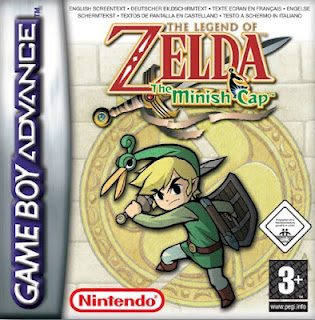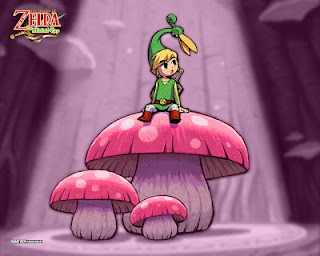The Legend of Zelda celebrates its 26th anniversary next week but Christopher Bell is looking back, not forward, in the first edition of Visual Memory – a brand new monthly column exploring classic games on extinct systems…
Legend has it that the kingdom of Hyrule is protected from an ancient darkness by the Picori Blade, a sacred sword entrusted to the royal family by the Minish – a race of Borrower-sized folk who can only be seen by children. Every century, the people of Hyrule celebrate their victory over the forces of evil by holding a royal tournament, at which the winner is allowed to touch the sacred blade. It just so happens that this year’s winner is an evil sorcerer by the name of Vaati, who shatters the sword, unleashing a tide of monsters on the land. To make matters worse, he turns the young princess Zelda to stone. It’s up to her young friend Link to track down the mysterious Minish, re-forge the Picori Blade and restore the princess…
The Minish Cap was the last of a string of handheld games developed by Capcom under the supervision of Nintendo, following Ocarina of Ages and Ocarina of Seasons (two games that could be linked together via password), and a re-release of Link to the Past.
But how did Capcom, the people behind Street Fighter, end up working on one of Nintendo’s biggest in-house properties? The answer lies in 1999, when Capcom approached Zelda’s creator, Shigeru Miyamoto, with a proposal to remake the original Legend of Zelda for the Game Boy Colour handheld console. Miyamoto refused. Capcom then gave him a staggering ultimatum – allow them to port the game, or they would develop an identical fantasy adventure with slightly different characters. Miyamoto gave in and, although a slew of development problems meant the remake of his original game never saw the light of day, Capcom eventually set to work on a number of original titles.
There is still a lot of classic Zelda DNA in The Minish Cap’s makeup though: travel the land, explore the dungeons, collect the keys, discover the special items essential to making progress, defeat the bosses, win the mystical treasure…
The ‘special items’ in this instance run from the usual bombs, arrows and boomerang to brand new objects such as the ‘Gust Jar’ (an ancient urn-cum-vacuum cleaner that allows Link to suck in items and enemies); ‘Mole Mitts’ (as you can guess, soft earth is no longer an issue with these gloves!) and the Picori Blade itself (after the sword is re-forged, Link can create copies of himself to activate multiple switches or move heavy objects).
But none of these items are half as fun to use as the titular headgear himself, the Minish Cap. Notice I said “he”. His name is actually Ezlo and, in a pre-hat state, he was a member of the Minish race. Putting him on allows Link to shrink down to the size of a Borrower, granting access to previously inaccessible parts of the kingdom. Unfortunately, in this miniscule state, water, cats and some enemies that may have been (mostly) harmless when Link was bigger, suddenly prove incredibly dangerous. The first boss is just a regular slime-based enemy, but that’s more of a problem when you’re only 5mm tall. You find the hat very early on in the game, so an entire new perspective on the world is open to you after a few swings of a sword.
Despite its short campaign length and easy difficulty, The Minish Cap received glowing reviews from the press. This is one of the more charming and whimsical-looking Zelda games out there, the art style successfully bridging the gap between the 16-bit Link to the Past and Gamecube title The Wind Waker. It’s full of those little “Eureka!” moments when you find a new path or solve a puzzle and is packed with throwaway details that have been picked up in more recent titles, such as Skyward Sword.
Sadly, the game was released on the Game Boy Advance just as the system was replaced by the dual-screen Nintendo DS, so it had a shorter shelf life than it really deserved. Still, this is where I first picked up the sword and really started to get into the series. If you can lay hands on a copy, you won’t be disappointed.
The Legend of Zelda: The Minish Cap (2004-Japan, 2005-US and Europe)
Developer: Capcom/Nintendo
Publisher: Nintendo
Formats: Nintendo Game Boy Advance (Also available through 3DS’ Ambassador Program)
Visual Memory will be back on Thursday 15th March to tackle a game of fallen angels, dodgy dialogue and poison chihuahuas… it’s the PS2’s fantasy beat-em-up, The God Hand.


